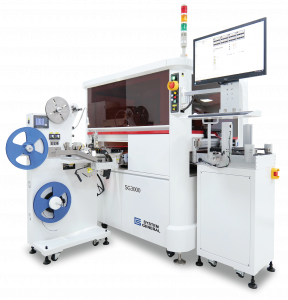Features
- Automated fine-pitch IC device programming system with dual-nozzle gantry design, optimized for maximum throughput
- Throughput up to 2500 devices per hour for high volume mass production
- Flexible multimedia I/O options including tray, tape and tube feeders
- Equipped with System General SG8000 Universal Programmers with up to 32 programming sites
- Supports UFS, eMMC, Nor/Nand Flash, EEPROM, CPLD, FPGA, Anti-Fuse and other customized IC/module
- Easy-to-use teach mechanism with minimum overheads for change-over
- One-piece-flow operation
- Downward CCD for pick & place position teaching and auto-teach mode
- 2 high-resolution upward CCDs or precisor to detect pickup offset and to align devices for accurate placement
- Task manager software for full subsystem integration
- Connection to project management software with USB interface and comprehensive statistics administration
- Supports various APIs for custom MES connections.
- Short changeover time for different programming jobs
- Optimized nozzle design with own airflow/vacuum controls for small and ultra-thin packages
Optional:
- Tape & reel input / output
- Tube input / output
- 2D / 3D inspection
- Laser marker
- Label feeder
- Ink marker at tape-out or tray-out
further information
The SG3000 fine-pitch automated IC device programming system was developed with maximum flexibility and throughput in mind. It has a dual-nozzle gantry and all input / output media like tray, tube and tape can be combined and are available without changeover. A tray stacker for up to 20 JEDEC trays is included as standard. In addition the system can be equipped with a laser unit for component marking, a 2D/3D inspection module or systems for label or ink marking. In order to handle also small, ultra-thin packages, each of the two nozzles has its own airflow / vacuum controls and pick-up adjustment. The system has up to 4 integrated SG8000 universal high-speed programming stations that provide up to 32 available programming sockets using gang-8 socket boards. Correct placement of components is ensured either mechanically using a precisor, or optically using two CCD cameras. Another feature are adjustable stepper motors for opening and closing the programming sockets.
Comprehensive user software:
The PUI software contains project management software to create pre-defined programming jobs (projects), project version control and password protection (administrator and operator mode). The software offers any possibilities and information to configure and save projects including serialization and comprehensive statistics administration. It also supports various APIs for custom MES connections. Created projects can be used in the SGx000 automated systems, as well as in the manual model SG8000.
The handler’s GUI contains in addition a task manager software with version control, password protection and any possibilities and information to configure and save automated programming tasks. Detailed reports and statistics are stored in separate folders and can be printed for documentation immediately or later.
Gang 8 socket boards enhance programming throughput by up to 8 times:
The 8-site gang socket boards allow to program 8 devices at a time and thus significantly increase throughput. Also serial numbering is possible for up to 8 devices each with its own serial number. For NAND flash devices, its isolated circuitries for each socket enable independent Bad Block management for each device, which ensures the highest yields as well as the highest programming reliability.
To allow for maximum flexibility, the socket boards can flexibly be used with any number of 1 to 8 sockets to easily adapt to any throughput requirements from low volumes up to mass production.
And as with any System General equipment, you receive maximum flexibility at minimum cost:
Most current programming algorithms are provided free of charge for download about every six weeks. New algorithm development is free of charge. True universal programmers. Socket boards can be used on manual programmers as well as on automated systems.




